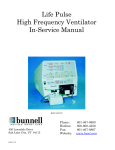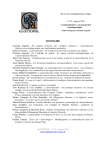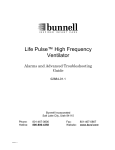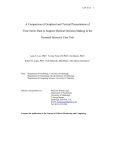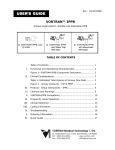Download HFJV - Women and Newborn Health Service
Transcript
WOMEN AND NEWBORN HEALTH SERVICE King Edward Memorial Hospital NCCU CLINICAL GUIDELINES SECTION: 2 RESPIRATORY PROBLEMS AND MANAGEMENT Section 2: Respiratory problems and management High frequency jet ventilation (HFJV) Date created: Dec 2012 Date revised: Review date: Dec 2015 Neonatology Clinical Care Unit Guidelines King Edward Memorial/Princess Margaret Hospitals Perth Western Australia Authorisation & review by Neonatal Coordinating Group HIGH FREQUENCY JET VENTILATION (HFJV) The Life Pulse High Frequency Jet Ventilator is a microprocessor-controlled infant ventilator capable of delivering and monitoring between 240 and 660 breaths per minute, hence it delivers very small tidal volumes at supra-physiological frequencies. ADVANTAGES OF HFJV As with all forms of ventilation, oxygenation is dependent on uniform lung inflation. HFJV achieves this by identifying an optimal PEEP for alveolar stabilisation. Collapsed lung units are recruited in part by the Jet Pulse, but also, when necessary, by the addition of low rate background sigh breaths via conventional ventilation (CV). The high velocity low tidal volume jet “pulses” minimise the effective dead space, thereby increasing ventilation efficiency. This strategy allows for optimal lung volume recruitment without exposing the lungs to high tidal volumes. Any injured areas of the lungs can rest and heal. In addition, the asymmetric flow profile associated with its fast inspirations and slow expiration enhances mucociliary clearance. Application from birth may limit the severity of lung disease by minimising volutrauma. In established inhomogeneous lung disease (eg pulmonary interstitial emphysema, pneumonia, meconium aspiration syndrome and evolving BPD), HFJV may provide benefit by resolution of air trapping and over distension. Note in this illustration the fresh gas shooting down the centre of the airways whilst the slower moving passively exhaled gas moves out along the airway walls. This countercurrent pattern facilitates airway clearance. COMPLICATIONS FROM HFJV ETT Obstruction (same as CV) Tracheal Injury (same as CV) Page 1 of 9 This document should be read in conjunction with the NCCU Disclaimer. Periods of hypocarbia within the first few days of life have been shown to be associated with the subsequent development of Periventricular Leukomalacia in preterm infants (2). Hyperinflation and Inadvertent PEEP (Air trapping resulting from inappropriately high ventilator rate) a. Pneumo/thorax/mediastinum b. Atelectasis PARENT EDUCATION Explain the purpose and function of the HFJV to the parents, stressing that the neonate will appear to have rapid vibrations of the chest wall, but will also be able to breathe spontaneously. Promote parental involvement in care as much as possible. Refer parents to Bunnell Parent information page: http://www.bunl.com/parents_page.html SELECTION CRITERIA / INDICATIONS FOR INITIATING HFJV HFJV may be started at the discretion of the Consultant for lung disease including but not limited to: a) Air leak syndrome including PIE or unresolved pneumothorax noted on CXR. b) Infants with lung disease who have failed CV and/or HFOV - particularly if they have non-homogeneous lung disease. COMMENCING HFJV FROM CONVENTIONAL VENTILATION (CV) Place a Transcutaneous Monitor(TCM) on the infant and Pulse Oximetry monitoring Plug the HFJV into the “Uninterrupted Power Supply” Install circuit into the HFJV (see Setting up on page 33) Attach water and place below level of humidifier Attach a clean 2.5 mm or 3.5 mm (as appropriate) HFJV LifePort adaptor to a clean test lung. Attach the pressure monitoring tube to the patient box. (Nb – if the patient has a 3.0 mm tracheal tube, it is easiest to reintubate and to use an uncut tracheal tube to attach the 3.5 mm HFJV LifePort adaptor). Connect this testing set to the installed circuit Turn the ON switch on Section: 2 Respiratory problems and management High frequency jet ventilation (HFJV) Date Revised: Dec 2012 This document should be read in conjunction with the NCCU Disclaimer Neonatology Clinical Guidelines King Edward Memorial/Princess Margaret Hospitals Perth Western Australia Page 2 of 9 Press SILENCE Run the SYSTEM test by pressing the TEST button – the numbers will change in sequence from 0 through to 9 Press the alarm SILENCE to silence at the end of the test Run the FUNCTIONAL test by pressing the ENTER button to start default settings (PIP 20, Rate 420, On-Time 0.02 s) Verify that READY condition can be met (approx 1 ½ min.), monitored pressures stable and PEEP is 0.0 Press STANDBY Connect the appropriate sized LifePort adaptor onto the infant’s tracheal tube whilst still running conventional ventilation (HFJV remains in STANDBY) remembering to keep pressure port plugged until HFJV circuit is connected Connect the circuit to the infant’s LifePort adaptor whilst in Standby mode. Connect pressure monitoring tube to the patient box Place on SIMV and turn off VG then adjust CVPIP to achieve a tidal volume of ~ 5 mL/kg Note baseline monitoring on the HFJV ventilator monitoring display whilst on CV (esp, PIP, and mean airway pressure) Set the HFJVrate (see “Strategies”) Set HFJVPIP (in the ‘Controls’ section) guided by the average CVPIP attained on the Ventview and monitored on the HFJV (PIP on the HFJV should initially be set at approximately the average PIP used during CV when mandatory (non-triggered) breaths are being delivered) Check that FiO2 is the same on both ventilators Then in quick succession: 1. Reduce CV rate to 2 breaths/min (see “Strategies”) 2. Turn CVPEEP up by 1-2 cmH2O initially 3. Press ENTER on the HFJV ventilator 4. Increase PEEP to meet mean airway pressure noted prior to switch to HFJV 5. Turn Minute volume alarm down to ‘0’ then high alarm ‘>2Lpm’ 6. Turn apnoea ‘off’ on the C.V. 7. Observe chest movement and increase HFJVPIP as required to achieve chest wiggle. If necessary, increase HFJV inspiratory time to 0.03 s. Monitor TCM PCO2 and Pulse Oximetry readings and observe any trends Increase PEEP if not holding acceptable Oxygen saturation readings and consider using a higher CVPIP to achieve recruitment breaths of 7-8 mL/kg in the setting of significant atelectasis. Check automatic alarm settings when ready light is showing (MAP +/- 1.5 cmH2O, Servo Pressure +/- 0.3-0.5 cmH2O) Obtain a confirmatory blood gas within 20 min of commencing to check accuracy of TCM PCO2. Blood Gas as indicated thereafter (utilize trending on the TCM) until the PaCO2 is within target range i.e. 45-65 mmHg Make sure the monitored pressures are stable and the Ready light is on before leaving the infant’s cotside. Be prepared to suction frequently within a short interval after commencing HFJV if the servo pressure decreases, or if the chest movement decreases. The READY light must be ON prior to suctioning. Note: The Enter button and Reset button should only be pressed as necessary to enter new control settings or to intentionally recalculate the alarm parameters, respectively. Section: 2 Respiratory problems and management High frequency jet ventilation (HFJV) Date Revised: Dec 2012 This document should be read in conjunction with the NCCU Disclaimer Neonatology Clinical Guidelines King Edward Memorial/Princess Margaret Hospitals Perth Western Australia Page 3 of 9 Click for simulated Bunnell Life Pulse HFJV controls: http://www.bunl.com/Interactive-Life-Pulse.html CV PEEP: Optimise PEEP to improve PaO2 (this will also improve PaC02). After CMVPIP, CVPEEP and CVrate have been optimised, and once oxygen saturations have come into range, attempt decreasing FiO2 as tolerated. NB. Adjust both FiO2 on CV and HFJV at all times simultaneously. Do not wean PEEP until FiO2 is ≤ 40%. Improving oxygenation requires increasing MAP by one or more of the following: ↑ CVPEEP ↑ HFJVRate ↑ HFJVPIP ↑ HFJVIT Inadvertent PEEP: Always monitor HFJVPEEP and CV PEEP. An HFJV PEEP reading which is higher than the CV PEEP is known as “Inadvertent PEEP”. Inadvertent PEEP indicates air trapping. Gas trapping occurs when tidal volumes have insufficient time to exit the lungs. Maintain optimal lung volumes as both over-inflation and under-inflation are injurious to the newborn lung. In the case of grossly overexpanded lungs, you will need to deflate considerably before any improvements in oxygenation will result. To minimise overexpanded lungs: ↓CVrate to 0 then ↓HFJVrate to lengthen exhalation time. In most cases do not decrease PEEP as hyperinflated lungs are usually a result of air trapping due to airway collapse, not excessive PEEP. HFJV PIP: The primary determinant of PaCO2 Controlled by changing the PIP in the Controls section “New” using the up and down arrow indicator buttons and confirming by pressing ENTER. ↓ HFJV PIP = ↑ PaCO2; ↑ HFJV PIP = ↓ PaCO2. Note – ↓HFJVPIP will also decrease MAP and may require reciprocal change in PEEP to maintain Oxygenation. Rule of thumb; the greater the ∆P, the lower the pCO2 (∆P = PIP – PEEP). Click for simulated Bunnell Life Pulse HFJV controls: http://www.bunl.com/Interactive-Life-Pulse.html MANAGEMENT: Homogeneous lung disease eg Respiratory Distress Syndrome, Pneumonia (esp. Group B Streptococcal) and Pulmonary Haemorrhage Choose an initial CVRate of 2-5 breaths/min depending on the severity of the disease process and the degree of under inflation. Maintain alveolar inflation using a PEEP of 6-12 cmH2O depending on the severity of the disease. HFJVPIP is started at ≈ CVPIP (see above). For patients with a very poor compliance, it may take a higher background CVPIP level to recruit atelectatic alveoli (eg. 26-34 cmH2O), but once recruited, optimal PEEP can be used to prevent loss of lung recruitment. The CV PIP and Rate can then be weaned appropriately. Section: 2 Respiratory problems and management High frequency jet ventilation (HFJV) Date Revised: Dec 2012 This document should be read in conjunction with the NCCU Disclaimer Neonatology Clinical Guidelines King Edward Memorial/Princess Margaret Hospitals Perth Western Australia Page 4 of 9 As compliance improves, FiO2 should be decreased before weaning PEEP. CV PIP and CVRate should be kept as low as possible. Clinically, improved compliance can be recognised by an increase in Servo Pressure (see “Servo Pressure”). *Air leak: Choose an initial CV Rate of 0 breaths/min (ie CPAP mode), or up to 2 breaths/min if coexistent atelectasis is a concern. Maintain alveolar inflation using a PEEP of 6-8 cmH2O depending upon the severity of the disease. Start HFVJ PIP at ≤ CV PIP and increase as required to achieve slight wiggle. This strategy is appropriate for most infants with PIE or Pneumothorax. Non-Homogeneous lung disease eg Meconium Aspiration Syndrome and focal Pneumonia Use lower HFJVrate (240-360 breaths/min) to avoid gas trapping. Use higher PEEP (8-12 cmH2O) to splint airways and allow meconium/secretions to evacuate in the swirling HFJV expiratory flow. UNDERSTANDING SERVO PRESSURE: Servo Pressure auto-regulates gas flow to the infant to keep monitored PIP=set PIP. Servo pressure changes as lung volume or mechanics change. (Note: Servo Pressure increase is usually good but it may indicate an air or circuit leak) Servo Pressure increases with: Improving compliance or resistance Leak around ETT Tubing leak Servo Pressure decreases with: Worsening compliance or resistance Obstructed ETT Bronchospasm Tension pneumothorax Right mainstem intubation Infant needs ETT suctioning Infant activity ETT SUCTIONING ON THE HFJV: Make appropriate preparations to suction Check that the HFJV Ready light is ON Place the Jet into the Standby mode Immediately suction the infant using the Ballards closed suction system with the in-built “elbow” then recommence HFJV by pressing ENTER Repeat the above 2 steps as often as required to achieve effective clearance of the secretions. Suctioning may need to be performed more frequently in the first 4-6 hours. Suctioning frequency may then subside Make sure the monitored pressures are stable and the Ready light is on before leaving the infant’s cotside. Section: 2 Respiratory problems and management High frequency jet ventilation (HFJV) Date Revised: Dec 2012 This document should be read in conjunction with the NCCU Disclaimer Neonatology Clinical Guidelines King Edward Memorial/Princess Margaret Hospitals Perth Western Australia Page 5 of 9 NITRIC OXIDE AND HFJV: Section: 2 Respiratory problems and management High frequency jet ventilation (HFJV) Date Revised: Dec 2012 This document should be read in conjunction with the NCCU Disclaimer Neonatology Clinical Guidelines King Edward Memorial/Princess Margaret Hospitals Perth Western Australia Page 6 of 9 Section: 2 Respiratory problems and management High frequency jet ventilation (HFJV) Date Revised: Dec 2012 This document should be read in conjunction with the NCCU Disclaimer Neonatology Clinical Guidelines King Edward Memorial/Princess Margaret Hospitals Perth Western Australia Page 7 of 9 WEANING FROM HFJV: Once the infant has cleared the maintenance phase, weaning can begin. Turn CV to CPAP mode Gradually wean HFJVrate to 240 breaths/min Decrease MV and MAP slowly by lowering HFJVPIP . Note: PEEP may need to be ↑ slightly to support MAP and oxygenation Lower FiO2 gradually as appropriate Once HFJVPIP is 15-25 cmH2O, and infant breathing regularly and spontaneously and maintaining acceptable PaCO2 then consider extubation (may trial ET CPAP briefly). If tolerated, extubate to a nCPAP device set at a level matching the final HFJV MAP, usually 6 – 8 cmH2O. Note: There is no need to change from HFJV to a CV mode before extubation. CLEANING AND STORAGE When High Frequency Jet Ventilation (HFJV) has been ceased, leave the Jet Ventilator by the bedside until completely satisfied the infant will not require the ventilator. A satisfactory blood gas sample, good TCM readings and oxygen saturations will confirm the decision to cease HFJV. The HFJV with its accompanying Drager can now be cleaned and set up ready for use. HFJV circuit - The whole patient circuit is disposable including the humidifier cartridge and green oxygen tubing. The Jet adaptor is also disposable. Non-disposable parts - Wipe over the patient whisper box, HFJV, Drager and its humidifier together with temperature probe and adaptor with hospital grade disinfectant. Set up as per Setting up HFJV Circuit procedure. Always check the Drager settings and function prior to moving for storage. SETTING UP THE HFJV CIRCUIT Open new circuit which comes as one complete piece with all connections secured Open humidifier door to slide cartridge in and lock Firmly attach the green tubing to “Gas Out” on the front left of the ventilator. Attach the thin clear purge tubing to “Purge” on the front right of the ventilator and to the Whisper Jet Patient Box (patient box) on the ventilator side Place a red IV cap on the end of the circuit (water pump tube) and then attach the Pinch tubing to the other side of the red cap to keep the circuit clean. Place the circuit into a plastic drawstring bag for protection until used Note: Leave the jet set up at this point when placing the jet into storage. The pinch tube will become damaged if stored loaded into the pinch valve. It is important to only proceed with the next steps just prior to the HFJV being used. Section: 2 Respiratory problems and management High frequency jet ventilation (HFJV) Date Revised: Dec 2012 This document should be read in conjunction with the NCCU Disclaimer Neonatology Clinical Guidelines King Edward Memorial/Princess Margaret Hospitals Perth Western Australia Page 8 of 9 Open water pump and insert the clear water inlet tube from the bottom right of the humidifier cartridge. Mind fingers when snapping the pump door closed! Press the “push to load” button on the top of the patient box and gently stretch the pinch tube into the pinch valve under the plexiglass cover on the patient box. Connect the water inlet tube to the short giving set and connect the water transfer tubing to the 1L water for irrigation bag and unclamp the transfer tubing. (Keep bag below ventilator to avoid gravity filling the humidifier cartridge). REFERENCES 1. Bunnell. Life Pulse High Frequency Ventilator In-Service Manual, pages 1-88; Salt Lake City http://www.bunl.com/index.html 2. Giannakopoulou C, Korakaki E, Manoura A, Bikouvarakis S, Papageorgiou M, Gougiosis D, Hatzidaki E: Significance of hypocarbia in the development of periventricular leukomalacia in preterm infants. Pediatr Int 2004 Jun; 46(3):268-73 3. Iowa Neonatology Handbook: Pulmonary: Management Strategies with High Frequency Jet Ventilation. Klein, J. 4. Bunnell. Technology & Clinical Bulletin, August 27, 2010. Section: 2 Respiratory problems and management High frequency jet ventilation (HFJV) Date Revised: Dec 2012 This document should be read in conjunction with the NCCU Disclaimer Neonatology Clinical Guidelines King Edward Memorial/Princess Margaret Hospitals Perth Western Australia Page 9 of 9











